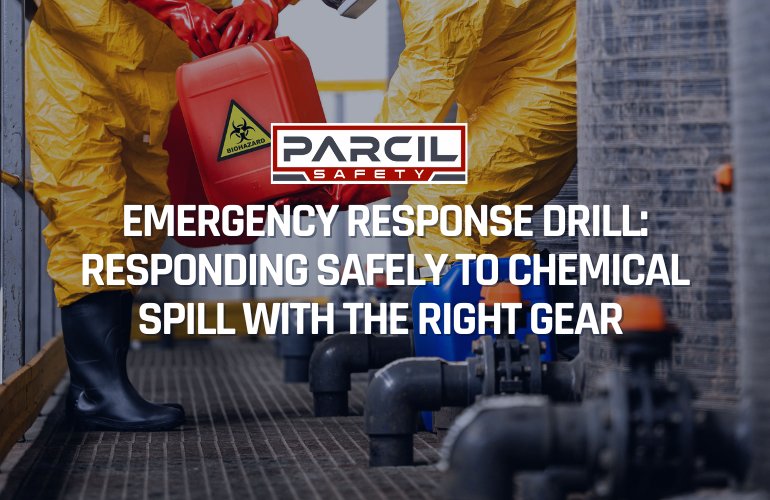When a chemical spill happens, quick action is essential. Even if it’s a minor leak or a larger spill, responding fast—and safely—can make all the difference to everyone’s safety. Just like how knowing what to do is important, having the right safety gear on hand is just as crucial.
Let's walk you through the steps of responding to a chemical spill safely featuring protective equipment like the ST-100x Full Face Respirator and a Hazmat Suit from Parcil Safety in keeping you and everyone else out of harm’s way.
How to Respond to a Chemical Spill

Handling a chemical spill requires more than just cleaning it up—you need to do it in a way that protects yourself and others. Here’s a step-by-step guide of what you need to do:
Step 1: Identify the Chemical You’re Dealing With

The first thing you should do is figure out what chemical has been spilled. Check the label, Material Safety Data Sheet (MSDS), or any other information that will tell you what kind of risks the chemical presents. Some chemicals might release harmful vapors, while others may cause burns or skin irritation. Knowing the hazard helps you choose the right response.
Protect Yourself with the Right Gear Here
Step 2: Put On Your Protective Gear

Once you’ve identified the spill, it’s time to gear up. Personal protective equipment (PPE) is critical—this is where the ST-100x Full Face Respirator and a Hazmat Suit come into play.
The ST-100x Full Face Respirator protects your lungs from breathing in harmful chemicals, while also shielding your eyes and face. Paired with a Hazmat Suit that covers your entire body, you can confidently approach the spill knowing you’re protected from fumes and direct contact with dangerous substances.
Protect Yourself with the Right Gear Here
Step 3: Contain the Spill

After putting on your PPE, the next step is containing the spill so it doesn’t spread. Depending on the chemical, you might use spill containment kits, absorbent materials, or barriers. Keeping the spill from spreading helps prevent further damage and keeps everyone else safe.
This is where the ST-100x really shines—its full-face protection and high-efficiency filters ensure you’re breathing safely, even if the spill releases harmful vapors or particulates.
Protect Yourself with the Right Gear Here
Step 4: Clean It Up

Once the spill is contained, it’s time for the cleanup. Make sure to use the right tools and methods for the specific chemical involved. Your Hazmat Suit provides a solid defense against skin exposure, while the ST-100x Respirator makes sure you're not inhaling any dangerous fumes or dust.
Protect Yourself with the Right Gear Here
Step 5: Dispose of Contaminated Materials

After cleaning up the spill, you need to properly dispose of any contaminated materials, including your PPE. Follow your facility’s guidelines or local regulations to ensure safe disposal. Once everything is cleaned up, remove and safely discard your used gear, knowing it’s done its job of keeping you protected and safe.
Protect Yourself with the Right Gear Here
Why You Need the ST-100x Respirator and a Hazmat Suit

Let’s talk more about why these two pieces of safety gear—the ST-100x Full Face Respirator and a Hazmat Suit—are must-haves for chemical spill response.
When dealing with chemical spills, inhaling harmful fumes or particles is one of the biggest risks. The ST-100x is designed to protect you from exactly that. Here’s why it’s the go-to choice:
Full Coverage: The ST-100x protects not just your lungs but also covers your eyes and face, shielding you from toxic fumes and chemical splashes.
Comfort and Durability: It’s made with soft silicone for a comfortable fit, which is important when you're working long hours.
Quick and Easy Filter Changes: Its bayonet-style filter system lets you swap out filters quickly so you can keep working safely, no matter what type of chemicals you're dealing with.
Meanwhile, a Hazmat Suit is essential to keep dangerous chemicals from coming into contact with your skin. Here’s why it’s important:
Chemical Resistance: A hazmat suit acts as a barrier, keeping harmful substances from touching your skin.
Easy to Move In: Even though it offers full coverage, these suits are designed to let you move freely so you can respond quickly and efficiently.
Complete Coverage: From head to toe, the hazmat suit ensures no part of your body is exposed, giving you peace of mind while dealing with hazardous chemicals.
When a chemical spill happens, your response needs to be quick, effective, and most importantly, safe. That’s why using the ST-100x Full Face




















Leave a comment
All comments are moderated before being published.
This site is protected by hCaptcha and the hCaptcha Privacy Policy and Terms of Service apply.